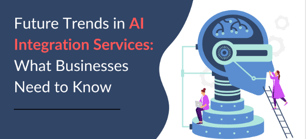Successful digital transformation replaces old, obsolete tools and processes with real-time, cutting-edge technologies. Software applications and intelligent systems that leverage AI speed work and improve customer service. A digital transformation strategy improves user experiences, streamlines operations, and increases employee productivity by transforming manual processes into high-speed digital ones.
Digital strategy does not focus on a single project. Instead, it outlines a series of projects and technology improvements. These changes help speed up and enhance how a company operates.
ITPros explains that these efforts "change every facet of an organization, from back-office operations to customer interactions." Companies that have a good digital transformation strategy can connect these different processes. Although this business transformation can be difficult, the ROI can be enormous. Companies that successfully become digital businesses are "more efficient, data-driven and nimble, taking advantage of more business opportunities.”
Digital Transformation Journeys Require a Cultural Shift

Transforming your business processes with digital technology means changing the way that cross-functional teams work. It involves challenging employees’ mindsets about existing processes. It applies mobile devices and innovative technology to better connect the organization and evolve employee experiences.
This cultural shift encourages faster, more accurate information flow across the business. It drives improved efficiency to achieve business goals.
These initiatives focus on more than just technology. They aim to change how a company views its business models. Digital Transformation requires a new way of thinking about how to evaluate and simplify tasks. Unfortunately, when companies choose to invest in digital technology, they often overlook the importance of culture and employee mindset.
Why Corporate Culture is Overlooked in Digital Transformation Initiatives
- Focus on Technology Over People: Many organizations see digital transformation as a tech challenge. They emphasize tools, platforms, and infrastructure. They often overlook the cultural change needed to fully adopt and use these technologies.
- Underestimating Change Resistance: Employees may resist new tools or processes. They might fear losing their jobs, lacking training, or having their routines disrupted. This resistance can slow down progress.
Why Does Digital Transformation Fail?
Digital transformation initiatives can fail when they don’t have executive support. If not thought through clearly, these initiatives will fail. Another roadblock can be a lack of commitment from the wider organization or project stakeholders.

A study by Everest Group found that 73% of companies did not benefit from their digital transformation efforts. Many companies invested in digital changes but saw no real value. This highlights a significant issue in how businesses approach digital transformation.
In the survey, 78% of companies did not meet their business goals. This means only 22% of projects reached their desired results.
Companies shouldn’t just buy new digital technologies and ask employees to use them. Digital transformation projects should review current workflows and processes with the goal of streamlining that work. Accurate data collection and fast delivery of data should also be a focus.
Strategy & Initiatives for Digitally Transforming Your Business
Remember that technology does not only automate tasks. It can also enhance information sharing and collaboration between employees, thus minimizing the time for making decisions. It can improve customer experiences, helping the company generate more revenue while reducing churn.
Digital transformation goes much beyond simply replacing outdated technologies or processes with newer ones. It requires a completely new approach.
Citizen developers need to take a careful look at routine business activities. They should understand how employees do this work, what processes they use, and where they could streamline efforts. They need to understand how the process uses business data and what data they need. Only then can they have a clear understanding of what employees need to perform their jobs better.
Once the team conducts a proper examination, they can identify where they can engineer processes with digital technologies. Companies can then take steps to source and assess specific digital tools or social media integrations that can help.
Further reading: MIT Sloan report on building digital workplaces.
Make a Cultural Shift To Support Digital Transformation Efforts
By understanding that digital transformation involves people and culture as much as technology, companies can achieve lasting success. Helping employees and changing the company culture is as important as gathering business requirements, ensuring security, or testing users for a successful implementation. Below are some guidelines you can use to prepare employees for digital transformation.
Adjusting the Culture for Technological Evolution
Digital transformation isn't just about implementing new technologies; it's about creating an environment where:
- Innovation is Encouraged: Employees feel empowered to experiment and think creatively using new tools.
- Collaboration Flourishes: Breaking down silos and fostering cross-departmental communication become essential for delivering seamless customer experiences.
- Adaptability Becomes a Norm: Organizations must constantly evolve and train employees to thrive in a fast-paced digital economy.
What Companies Should Do
- Prioritize Digital Culture: Cultivate a mindset that embraces change and continuous learning at every level of the organization.
- Invest in Leadership Development: Equip leaders to champion digital initiatives and model flexibility and collaboration.
- Empower Employees: Use low-code/no-code platforms or other tools to involve non-IT employees in innovation.
- Measure Cultural Readiness: Regularly assess and address gaps in employee engagement, skills, and digital confidence.
Understand the Costs of Digital Transformation
When thinking about digital projects, it's important to consider both the direct financial costs and the hidden expenses. Make sure you consider these 4 areas that can drive up costs of a digital implementation:
1. Direct Costs
- Technology Acquisition: Expenses for software, hardware, cloud services, and other tools required to modernize operations.
- Implementation Costs: Costs associated with integrating new systems into existing infrastructure, including consulting fees, third-party integrations, and custom development.
- Training and Development: Investment in upskilling employees to use new tools and platforms effectively.
- Data Migration: Transferring data from legacy systems to new platforms, which can be resource-intensive.
- Ongoing Maintenance and Updates: Subscription costs, licensing fees, and system updates required to keep the technology running optimally.
2. Indirect Costs
- Downtime During Transition: Temporary drops in productivity as employees adapt to new systems.
- Employee Resistance: Potential delays or inefficiencies caused by resistance to change, requiring additional resources for change management.
- Opportunity Costs: The time and effort spent on transformation projects that could have been used elsewhere.
- Legacy System Dependencies: Challenges in phasing out or integrating old systems that are deeply embedded in workflows.
3. Hidden Costs
- Offline capabilities: Offline features have been one of the most expensive aspects of app development.
- Cultural Shifts: The cost of changing workplace culture to use digital tools. This may involve restructuring teams or redefining roles.
- Security Investments: Enhancing cybersecurity to protect sensitive data in digital formats, including compliance with regulatory standards.
- Vendor Lock-In: Presents risks and costs when businesses rely on specific vendors for software or services.
- Ineffective Implementations: Expenses incurred from poorly executed transformations that fail to deliver ROI and require reinvestment.
4. Long-Term Costs
- Scalability Issues: Future costs of expanding digital solutions to accommodate business growth.
- Innovation Maintenance: Staying competitive might require constant investment in newer technologies as they evolve.
- Skill Gaps: Ongoing need for hiring or training employees with advanced technical skills.
Mitigate the Cost of Going Digital
Up-front planning can speed projects and dramatically lower the cost of a project. Solid planning will likely increase your return on investment, so be sure to cosnider:
- Conduct Clear ROI Planning: Calculate and justify the costs of transformation based on expected returns.
- Practice Phased Implementation: Break the transformation into smaller, manageable projects to spread costs over time.
- Leverage Automation: Use automation tools to reduce manual workloads and save on labor costs.
- Collaborate with Vendors: Negotiate with technology providers for better pricing and support during implementation.
Measure the Impact of Digital Transformation Initiatives

All this may sound abstract, but these initiatives offer substantial payoffs for companies who do it right. IDC says that digital transformation projects could add $18 trillion in business value worldwide.
A Gartner report found that 66 percent of companies adopting digital transformation expect to generate more revenue. In addition, 48 percent of companies believe that digital channels will bring in additional business. As for other benefits, 40 percent of respondents to the Gartner survey said new digital tools will empower employees. Thirty-nine percent said it will reduce costs.
Organizations that respond to the changing times are clearly the ones that will be ahead of the game. These companies are asking employees to use new technology. This will help make processes easier, reduce costs, boost efficiency, and enhance customer results.
How to Measure Success in Digital Transformation Projects
Measuring the impact of digital transformation initiatives involves assessing their effect on business performance, customer experience, and operational efficiency. Here are three effective ways to measure their success:
1. Key Performance Indicators (KPIs) Linked to Business Goals
- Align KPIs with the objectives of your digital transformation initiatives to track tangible outcomes.
- Revenue Growth: Measure increases in sales, market share, or customer lifetime value.
- Customer Retention/Acquisition: Track churn rates and new customer acquisition metrics.
- Cost Savings: Evaluate reductions in operating expenses, process inefficiencies, or technology maintenance costs.
- Example: To improve customer experience, track relevant metrics like the Net Promoter Score (NPS) and the Customer Satisfaction Score (CSAT).
2. Operational Efficiency Metrics
- Assess how digital initiatives streamline internal processes and reduce manual effort.
- Process Automation Rates: Measure the percentage of processes automated versus manual workflows.
- Time Savings: Track reductions in the time taken to complete key tasks (e.g., order processing or service delivery).
- Error Rates: Monitor the decline in human errors after implementing new systems or automation tools.
- Example: Calculate how much faster automated tools process invoices compared to legacy systems.
3. Employee and Customer Engagement Metrics
- Gauge how digital transformation impacts user satisfaction and adoption rates.
- Employee Productivity: Use metrics like output per employee or time spent on high-value tasks.
- User Adoption Rates: Measure how many employees or customers are actively using the new digital tools.
- Customer Engagement: Analyze metrics like website traffic, mobile app usage, or interaction with digital services.
- Example: Increased employee adoption of a collaborative platform could correlate with faster project completion times.
By focusing on KPIs, operational efficiency, and engagement metrics, you can evaluate how well digital transformation initiatives work. This helps align them with important business goals.
Digital Transformation "How-To" Whitepaper:
Digital transformation requires technologies that harness and make sense of vast amounts of data companies collect. Initiatives should consider mobile, cloud computing, artificial intelligence, machine learning, and IoT.
Best Practices for Driving Digital Transformation at Your Organization
How to Design the Right Digital Transformation Strategy
The authors of the ITPros article note that the key to success is designing the right strategy. A related Deloitte report, “Strategy, not Technology, Drives Digital Transformation,” warns companies not to focus only on technology adoption. He advises companies to use it as a means of overall business transformation.

In "Take-Two Technology Roads to Digital Experience Success," Forrester analyst Ted Schadler offers straightforward advice. He outlines the initial steps to take for success in digital experiences. He advises businesses to give first priority to investments that benefit customers and generate business value.
After that, companies should follow two paths at the same time. They should start quick projects that provide fast results. They also need to focus on long-term change.
The long-term path will ultimately have a bigger payoff. He suggests, "define the digital transformation outcomes you desire and then select and implement a modern platform." According to Schadler, this will deliver long-term agility and capabilities. He makes it clear that companies should leverage cloud technologies: "It's the future of digital experience platforms."
Digital Transformation Resources

Previously, leveraging technological advances was a challnge. Software developers were hard to find and hire and the software wasn't easy for non-developers to use. Everything has changed with the advent of low-code and no-code software.
Now, even the smallest businesses can effortlessly construct basic applications. Companies that are more ambitious can implement wider digital transformation strategies. These tactics might include data cleansing, extensive data analytics, and even Robotics, AI/ML, or IoT.
We've assembled some data, guides, and advice to help you get started:
- Speed Digital Transformation Whitepaper - Organizations face a growing demand for mobile apps but struggle with a shortage of skilled developers. A solution lies in empowering "citizen developers"—non-IT employees trained to create business apps using low-code and no-code platforms. This approach helps companies increase app development without expanding IT teams. By enabling business users with intuitive tools and proper training, enterprises can meet app demands while maintaining governance, security, and design standards. IT departments play a critical role in guiding this shift, ensuring effective policies and oversight. This strategy accelerates digital transformation, reduces app backlogs, and fosters innovation across all business areas.
- MIT Sloan School for Management: The Digital Workplacje Report - A report from MIT Sloan researchers highlights the critical role of creating a digital workplace to thrive in the digital economy. Success hinges on transforming how work is done, emphasizing employee experience, connectedness, and responsive leadership. The paper outlines four key recommendations for CIOs to develop effective digital workplaces and includes best practice case studies from organizations that have successfully made the transition. This transformation fosters innovation, enhances employee satisfaction, and drives competitiveness in the digital age, making the digital workplace essential for organizational success.
- Digital TransFormation is Tough: Here's A Helpful List - A survey of 650 IT leaders shows that digital transformation is important but difficult. Organizations face barriers like integration issues, limited resources, and IT-business misalignment. Despite high stakes, 74% are undergoing transformations, yet struggle to meet demands. Inefficient processes and rising workloads hinder progress, risking revenue loss without change.
- Questions to ask to accelerate your company's digital transformation - Rapid digital transformation requires asking critical questions, says MIT researcher Stephanie Woerner. Companies should evaluate digital threats, choose the best business model, identify competitive advantages, integrate mobile and IoT, and ensure leadership readiness. Avoid focusing solely on outdated goals; instead, embrace ecosystems and customer-centric strategies. Tools like Alpha TransForm help businesses transform digitally faster and more securely. They enable better collaboration between IT and business users.
The Best Digital Technologies to Transform Your Business
The meaning of digital transformation is not just limited to leveraging advanced technologies to streamline processes and drive efficiencies. Also, it enables organizations use and analyze data for better business outcomes. This way, they can understand the large amounts of business information they collect. Initiatives should consider mobile, cloud computing, artificial intelligence, machine learning, and IoT.
Initiatives should consider mobile, remote work, cloud computing, artificial intelligence, machine learning, and IoT.

Finding the right mobile app development platform that delivers outstanding customer experiences is critical. Your solution should work with your current software.
It must collect more accurate data. It should also use the benefits of mobile computing. Alpha Software, based in the United States, provides top technology for high returns on digital transformation projects today.
Alpha Software offers digital transformation technology that consistently receives 5-star reviews from customers and exeeds user expectations.
Developers can get a free license to create mobile apps using the company's low-code software platform. Citizen developers can also get a free license for the company's no-code app builder.
Examples of Successful Digital Projects

You don’t need to work for a large enterprise with a large budget to become a driver of digital transformation. Here are examples of companies used low-code software to start a digital transformation project.
- Morgan Lambert is a UK-based company that specializes in gas and electrical safety management for public housing projects. The company wanted to speed energy inspections, improve safety and cut costs. By abandoning paper audits and moving inspections to mobile apps, the company sped work and improved safety.
- The City of Islip, New York needed to move paper and manual processes digital to better serve citizens. One developer was able to digitize many paper-based processes with low-code software. He built more than 60 apps in months, a process that would’ve taken more than a year with other methods.
- GBS Enterprises provides a wide range of "protection" services to the furniture, mattress and bedding, and pest control industries. The company aimed to increase the productivity of its field service workers as well as the rest of the enterprise. The company digitized its call center and service dispatch operation by adopting mobile forms. Since going digital, the company has realized an 80% increase in productivity.
- The Royal Borough of Windsor built Volmapp - a mobile app for vulnerable citizens during the COVID-19 pandemic. It connects users to the services they need, including transportation to doctor's appointments, prescription delivery, and more. The app takes the process entirely paperless, speeding work and creating a faster more informed customer experience.
Digital transformation involves leveraging technology to enhance business operations, improve customer experiences, and drive innovation. It requires aligning cultural shifts, employee empowerment, and modern tools to achieve sustainable growth and competitive advantage. The strategies and tools in this article can help your organization adopt technology and achieve business success.








Comment